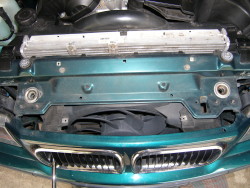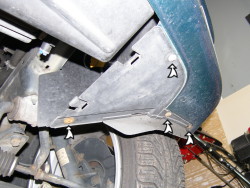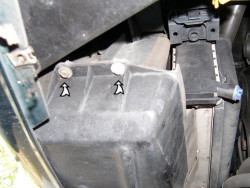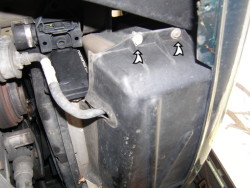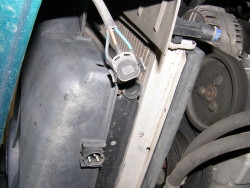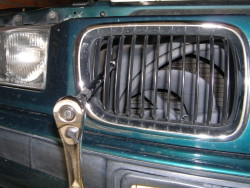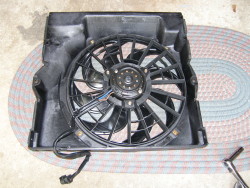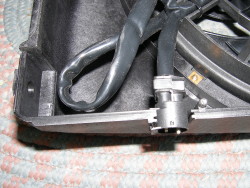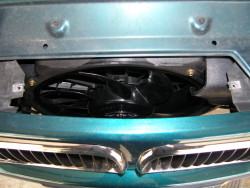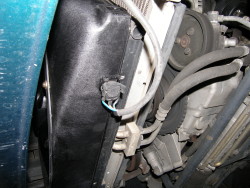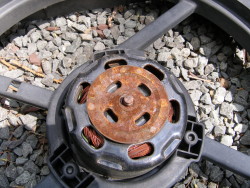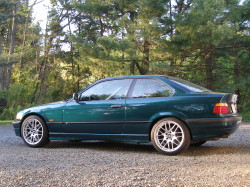BMW E36
Auxiliary Fan Replacement DIY
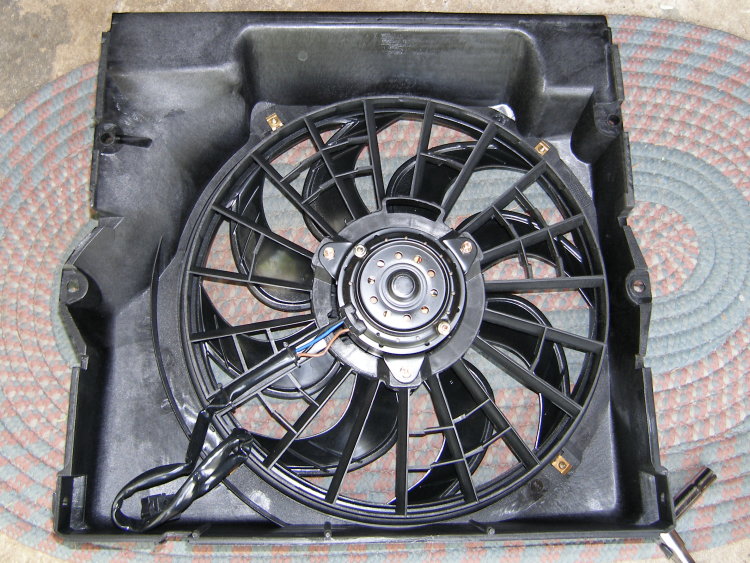
Contrary to what its name might imply, an auxiliary fan is an essential part
of the
BMW cooling and air conditioning systems.
Introduction
BMW E36 and some E46 models (usually ones with automatic transmissions) have two fans. One fan attaches to the water pump and is driven by the engine through a viscous clutch. This fan resides behind the radiator and pulls air through it. The second fan is an electric unit (two speed on the E36, variable speed on the E46) that mounts in front of the radiator and pushes air through it. This article concerns itself with the latter fan, which is otherwise known as the "auxiliary fan", or "aux fan" for short. This article specifically outlines the procedure to troubleshoot and replace a fan on the E36. Many of the principles should apply to the E46 as well.
Background
The aux fan serves two purposes. It forces air through the engine coolant radiator and automatically turns on at a low speed if the temperature of the coolant rises above a certain level. If that is insufficient to dissipate the heat being generated by the engine the fan speed increases if a higher temperature threshold is exceeded. The second purpose of the aux fan is to force air through the air conditioning condenser (mated to the engine coolant radiator) when the air conditioning system ("snowflake" button) is on.
Most people don't give the aux fan much thought. When it turns on at low speed it's practically inaudible, and as long as the engine driven fan is doing half a job in temperate conditions while the car is moving the coolant rarely reaches a high enough temperature to turn it on in the first place.
The first sign that the aux fan has failed may be warmer than expected air from the interior vents when the air conditioning is on and the car is at a standstill or in stop-and-go traffic. Still another sign is a rattling noise coming from the air conditioning compressor located at the front lower right section of the engine bay. This is caused by a pressure buildup in the air conditioning system that is a direct result of insufficient airflow through the condenser. Running the air conditioning without a functioning aux fan can damage the compressor, the replacement of which costs over $1000.
In high ambient temperatures, another possible indication of an aux fan problem is a rise in the coolant temperature needle beyond the usual 12 o'clock position. Regular readers of my site know I've said it many times -- you do not want to overheat a BMW engine. The result is usually a very costly top-end repair.
Troubleshooting
Fortunately, the failure modes of the auxilliary fan are pretty obvious so troubleshooting is relatively easy.
To check for proper aux fan operation, simply turn on the air conditioning (snowflake button) with the engine idling and walk around to the front of the car and look into the grills. The aux fan should be running and eventually cycling on and off without any undue noise. The fan should also coast to a stop quietly over a period of 5 seconds or more. If it makes strange noises or grinds to a halt, replace the fan. If the fan does not run at all and you hear the A/C compressor chattering, turn off the air conditioning and prepare for some additional troublesooting.
First of all, check the fuse (30A) and replace it if necessary. Fuses don't wear out...they only blow in response to a short or overload. This is most likely to occur in this context if the fan's bearings are shot and the fan takes far longer than usual to spool up. If the fuse blows again in short order replace the fan. Do not install a larger fuse in an attempt to make it work, even temporarily, or you will learn first hand what an electrical fire in a BMW smells like.
If the fuse is in good shape or it's been replaced and the fan still refuses to run, turn the ignition to postion 2 (run) and pull the electrical connector off the coolant temperature sensor located on the right side of the radiator. With a piece of solid wire of appropriate gauge, carefully short the middle terminal with either of the outer terminals. One of the outer terminals will close the low speed relay and cause the fan to run at the lower of its two speeds, while the other outer terminal will close the high speed relay and cause the fan to run at a noticeably higher (and louder) speed. If the fan runs at one speed but not the other the most likely cause is a failed relay.
If the fan runs continuously without the key in the ignition, the culprit is usually a stuck low or high speed relay. Since this condition will quickly result in a dead battery, the aux fan fuse should be removed until a new relay can be installed. Be advised that running the car in hot weather with the aux fan disabled in this manner may cause the engine to overheat.
Note: While troubleshooting the E46 aux fan is outside the scope of this document, I'll point out that the E46 design replaced the individual relays with a speed controller integrated with the fan. If the fan runs erratically, continuously with the key removed from the ignition, or not at all (and the fuse is good), the speed controller has failed and the entire fan must be replaced. That's progress for you.
Prerequisites
Replacement of the E36 auxiliary fan requires the following:
- Electric pusher fan and frame, BMW part number 64508364093
Alternative Source #1: Koala Motorsport
Alternative Source #2: Pelican Parts - 3/8" drive ratchet
- 3/8" drive, 12" extension
- 3/8" drive, 10mm six or twelve point socket
- 3/8" drive, 8mm six or twelve point socket
- Philips screwdriver
- A few cable ties (ty-wrap or similar)
- 1 hour of your day
BMW charges a bunch of money for this repair, but for once the reason is not the cost of labor -- it's the cost of the aux fan or what BMW calls the "pusher fan" in its parts inventory. This part retailed for the astonishingly high amount of $642 in early 2008. Fortunately this part may be obtained from two alternative sources as shown above. In both cases the savings are over $400. I bought the Koala part at the time I performed this repair and saw no markings on it to indicate a brand or location of manufacture. The part provided by Pelican Parts is branded VDO, which is BMW's OEM. In order to keep costs down, I strongly advise replacement of the fan with a non OE part simply because this is not a finely tuned proprietary suspension component that will never quite perform like the OE parts. It's a simple two speed fan.
Procedure
Removing the old fan
The fan is installed in a frame that helps duct the airflow over the radiator assembly. The BMW TIS notes that it is possible to replace just the fan or the fan and frame as a unit.
Based on a comment from the parts supplier the fan and frame are ideally replaced as a unit because the frame is made of a plastic that typically becomes brittle with age and the frame may not survive the installation of the new fan. After seeing the 10 year old part I agree.
The TIS further advocates removal of the front bumper cover (below the grills) to pull the fan and frame assembly out of the car. Based on my experience this is not necessary. Here's what I did instead:
- Remove the black plastic cover located on top of the radiator. This cover ducts air to the alternator and is attached to the radiator support and surrounding area by four screws and two plastic fasteners on the far left and right side.
- Jack up the front of the car. I jacked the car up slightly higher than usual so I would have a bit of extra room to pull the fan assembly out of the car from below.
- Remove the covers protecting the fog lamps. The fog lamp covers are installed to the underside of the bumper cover on the far left and right sides and have a vertical protrusion in them. You'll need 8mm or 5/16" sockets to remove 3 of the fasteners, and (at least on my car), a philips screwdriver to remove one of them. Not sure why, but it may have something to do with the fact that the front of the car has been disassembled several times.
- Remove the cover protecting the underside of the radiator / air conditioning condenser assembly. This is held in place with two 8mm screws on either side. Once those screws are removed, the cover is removed by pulling down and aft, taking care not to damage the pipes leading to the condenser.
- Remove the fan/frame assembly. It is held in place by six (6) 10mm screws. The top two screws are accessed through the grills by the use of a 12" extension. The middle two screws are best accessed from beneath the vehicle using either a deep socket or a shallow socket with a 2-3" extension. These are the most difficult to reach, but not outside the grasp of one's limited patience. The bottom two screws (which were missing on my installation) are easily accessible on the bottom of the fan assembly. After all screws are removed, disconnect the power connector and then pull the fan assembly downward. It may not want to come out at first, but be persistent. Just make sure that you don't damage the condenser when yanking on it.
- If available, use compressed air to blow out any dirt or debris that has wedged itself in the bottom of the condenser.
Installing the new fan
- Prepare the fan. Mine came with the power connector wiring ty-wrapped in such a way that the connector would not reach the hole in the frame designed to accept it, so I clipped the tie wrap, installed the connector on the frame and then put a new tie wrap on the wiring so it wouldn't flop around and rub against anything. I should also point out that the design of the connector was not identical to the OE with respect to how it mounted on the frame. Fortunately, the mating and keying of the connectors were identical, and that's all that really matters.
- Mate the power connector plug (car) with the receptacle (fan). Just before I reinstalled the fan I mated the power connector and receptacle. I used a pair of channel lock pliers to fully seat the connector, but noticed that the plug's retaining clips did not mate as well with the receptacle due to deterioration of the plastic on the 10 year old plug. To prevent accidental (and invisible) disconnection of the power connector I used another ty-wrap to compress the retaining clips around the connector base.
- Reinstall the fan and test it. Make sure the screws are tight and all tools are clear of the engine driven fan, and then start the engine (yes, with the car still jacked up). Then it the snowflake button to turn on the air conditioning and walk around to the front of the car. You should notice your fan purring nicely. If the fan is not operating, check the power connector at the base of the fan and make sure it's seated. If this still fails to turn on the fan, I suggest you turn off the engine for now and consider troubleshooting other aspects of the cooling fan electrical system including the low speed fan relay. While troubleshooting these aspects of the system are outside the scope of this DIY, some are covered elsewhere on this site.
- Reinstall the covers and put the front of the car back on the ground. You're done!
Highlights
Conclusion
Of all the work I've done on this car I must admit that this was one of the most rewarding simply because of the cost savings involved.
I advise anyone who is looking to replace their aux fan to use the aftermarket part provided by Koala Motorsport.
If your fan is not working and the cause is not obvious, check the electrical connector at the base of the fan. Sure, accessing it requires some work to remove the three covers, but based on the quality of the connection and the nature of the latches on the electrical connector I can see this coming loose with the vibration of the fan. This explains why I fastened it tightly with a ty wrap.




